Home
February 2021 - 10dB (ish) Attenuators.
This is an example of a really simple homebrew test equipment project.
For the price of a few resistors and perfboard - plus some SMA plugs
and sockets, you can build something that will be useful for years to
come.
While Nick G8INE and I were having fun building the N6QW Direct
conversion receiver (from the Spring 2021 Sprat ) we suspected that perhaps the
mixer injection from the Si5351 local oscillator was perhaps a little
high (in our examples) and causing undue internal noise?
But we needed to confirm that. One way
to have tested the idea was to have altered Pete's code for a lower
output from the Si5351 - but we thought that simply attenuating it a
little would be just as good.
So we needed some attenuators.
At the early stage of building I was also using my Chinese MHS-5200A
Signal generator as the VFO.
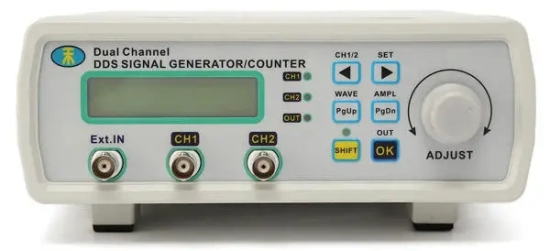 ....and it is not designed to produce an output a signal below 200mV.
....and it is not designed to produce an output a signal below 200mV.
That seemed too high a level for the mixer that I was using. In
addition when we got to the RF amplifier stage, a more realistic (low)
signal level was needed to test the input. So here then was yet another
need for some handy attenuation.
As is often the way when we collaborate on something, Nick and I go off
on
a tangent and spend time there before returning to the project. Of
course, you can easily buy attenuators for around £15 on Amazon/Ebay
but
that requires patience for the order to arrive - and where is the fun
in
that? I already had a pretty nifty digital attenuator - so I tried the
idea and indeed it did seem that the receiver sounded just slightly
less noisy - but perhaps not so much that it mattered greatly for this simple receiver.
Just a quick mention of my cheap signal generator. It has been very useful
and I do not regret buying it, It is built down to a price of course
and it cost about £50 a couple of years ago. The menu interface is a
bit weird - but you get used to that and the sine wave output only goes
up to 25MHz - but that covers most of my needs. The output is really
awful with the level turned up as high as six volts. Turned down low, the ouput is acceptable.
You will rarely
ever need output as high as 6 volts with radio work. So how low would it be
useful to go?
This web page shows a chart of signal levels versus "S"
reading.
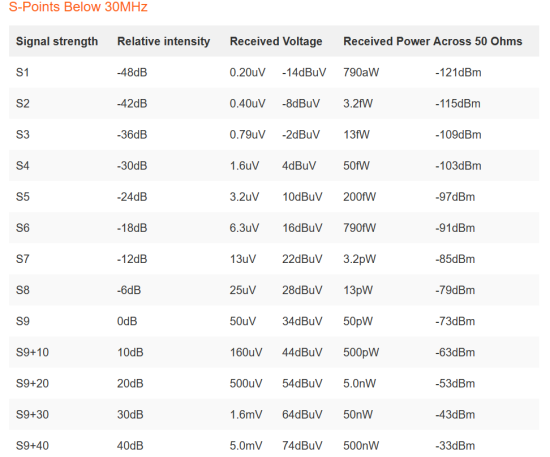
An "S9+40dB" signal would be measured as 5mV (into a 50 ohm load). Good
luck measuring voltages that low with a hobby oscilloscope. As stated, my signal generator
can only be set as low as 200mV but I can measure that. if I then add a
known attenuator I can calculate what level of signal is coming from
the output.
With all three attenuators (described below) a 200mV signal has 7.35mV coming
out of the attenuator.
That would be a signal just over "S9+40dB". So
you can see how we can get low level signals easily into the ballpark
that we might want.
As we were writing up the building of Pete's project it occurred to us
that a variable digital attenuator might be overkill for other
constructors to have on the bench. So we went in two directions. Nick
produced a nice homebrew switched attenuator and I built the "10dB ish"
attenuators that are the subject of this article.
Hams have been making resistive attenuators for years. Often they have
toggle switches to select the desired attenuation. As you go up in
frequency, the wires, component leads and switch characteristics cause
attenuation and impedance to change and often screening between stages
is required.
You can see how Nick handled that with his neat 80dB four stage attenuator. He can switch in 20dB stages.
He also added good screening between stages and he even used surface
mount resistors to get a superior HF performance. The gerber files are available here.
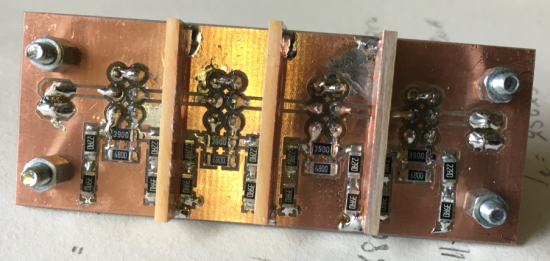
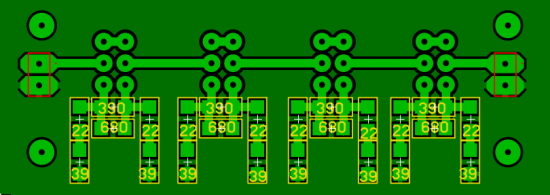
I went for a simple fixed attenuator (or three of them) and having terminated
them in SMA connectors, they can be plugged in when needed. (see photo below).
I tested mine using a NanoVNA (Vector Network
Analyser). Even if you do not have one, you
probably know someone that does - and once tested you know exactly what
attenuation they offer.
Here is all three of mine connected together.
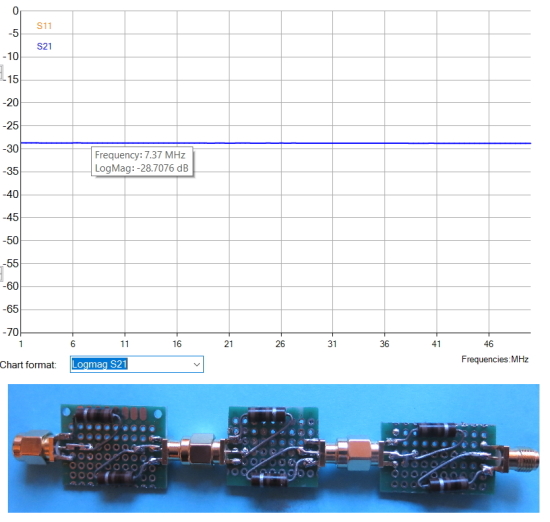
Using an online calculator I chose standard resistors that would get me
close to 10dB for each. I designed them to be 50 ohms in and out. Then using small pieces of perfboard I built them as shown.
Once the attenuators were built I tested them using a NanoVNA and of course, they weren't exactly round numbers. Hence "10dB
ish". But they performed pretty well across the part of the HF spectrum
that interests me. They would be virtually the same "10dB ish" value
wherever I needed them to be in the HF spectrum.
Once I had the output of my signal generator turned down to 200mV and added
one attenuator to the output and I measured the output at around 64
milliVolts
I created a small spreadsheet to calculate the output from an
attenuator for a given input. The result was close enough to the measured voltage. I have tested the spreadseet in an old copy of Excel and the latest LibreOffice.
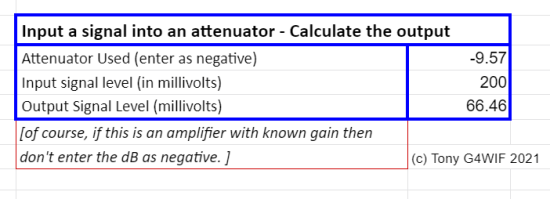
So do we need an attenuator to be an exact whole number? I suppose
the
answer relies on what you want to achieve. If you need lab grade
measurment then you probably need lab grade test equipment - but as a
home constructor you can get away with far simpler and inexpensive test
gear.